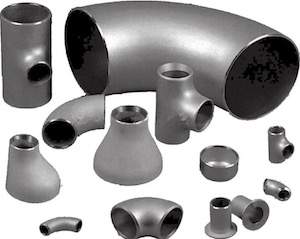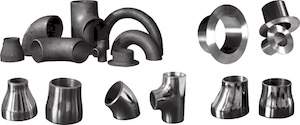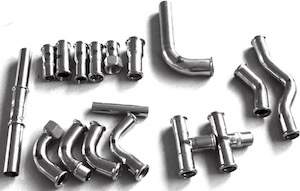Classifications of Stainless Steel Pipe Fittings
Posted: 04/26/2023 06:44:34 Hits: 11
A stainless steel pipe fitting is a kind of pipe fittings, including stainless steel elbows, stainless steel tees, stainless steel crosses, stainless steel reducers and stainless steel plugs. The main stainless steel materials are 304, 304L, 316L and 316L. According to the connection method, it can be mainly divided into the following categories.
Socket welded stainless steel pipe fittings
Insert the stainless steel pipe into the socket part of the pipe fitting, and then perform argon arc welding along the edge of the pipe fitting. It is the most reliable connection among all connection methods. According to the different welding parts of the pipe fittings, it can be further divided into three types: slope edge extension, step edge extension and no extension edge. The sizes of socket welding stainless steel pipe fittings are generally DN15 to DN100. Its appearance is shown in Figure 1.

Figure 1 Appearance of socket welded stainless steel pipe fittings

Figure 1 Appearance of socket welded stainless steel pipe fittings
Butt-welded stainless steel pipe fittings
Butt welding pipe fittings are generally used for welding larger stainless steel piping systems. See Figure 2 for butt welded stainless steel fittings.

Figure 2 Butt welded stainless steel pipe fittings

Figure 2 Butt welded stainless steel pipe fittings
Compression-type stainless steel pipe fittings
Compression-type pipe fittings have features of reliable and safe connection, convenient and fast construction. The working principle of the compression-type pipe fitting is to insert the thin-walled stainless steel tube into the socket of the compression-type pipe fitting, and use the special compression tool to stick the stainless steel pipe in the pipe fitting.
The cross-section of the clamping part is hexagonal. The stainless steel pipe and the pipe fitting are sealed by a mouth-shaped sealing ring, which makes it have the characteristics of anti-leakage, anti-drawing, anti-vibration and high-pressure resistance. Therefore, it is a relatively advanced connector in direct drinking water systems, tap water systems, heating systems, steam systems, industrial oil pipe systems and industrial air pipe systems, which is suitable for water, oil, gas and other pipeline connections. Press-type stainless steel pipe fittings are shown in Figure 3.

Figure 3 Compression stainless steel pipe fittings
Manufacturing standard: GB/T 19228.1-2003
Nominal pressure: less than and equal to 1.6MPa
Applicable temperature: -20 to 110°C
Applicable media: oil, water, gas and other non-corrosive or corrosive media
Materials: Stainless Steel 304 and 316L
Applications of stainless steel pipe fittings
Stainless steel elbows are used for the places where pipe fittings turn.
Stainless steel flanges are used to connect two pipes.
The stainless steel tee is used to connect three pipes.
Stainless steel pipe crosses are used to connect four pipes.
Stainless steel reducers are used where two pipes of different diameters are connected.
Matters needing attention when welding stainless steel pipe fittings
Be sure to use a power supply with vertical external characteristics, and use positive polarity for direct current (welding wire connected to negative pole). It is generally suitable for welding thin tubes below 6mm, and has the characteristics of beautiful weld shapes and small welding deformation. The back protection gas is box gas with a purity of 99.99%. When the welding current is 10 to 50A, the argon gas flow rate is 8 to 15L per minute; when the current is 50 to 250A, the argon flow rate is 12 to 15L per minute.
The length of the tungsten electrode protruding from the gas nozzle is preferably 4 to 5mm, 2 to 3mm in places with poor shielding such as fillet welding, and 5 to 6mm in places with deep slots. The distance from the nozzle to the working site is generally not more than 5mm. To prevent the appearance of welding pores, if there are rust and oil stains on the welding parts, they must be removed. When welding ordinary steel, 2 to 4mm is the best; when welding stainless steel, the best is 3mm; if it is too long, the protection effect will be poor. When butt-priming, to prevent the back of the bottom welding bead from being oxidized, gas protection is also required on the back. To make the argon gas well protect the welding pool and facilitate the welding operation, the centerline of the tungsten electrode and the weldment should generally maintain an angle of 800 to 85, and the angle between the filler wire and the surface of the workpiece should be as small as possible, generally 0. Where there is wind, screens should be set, and indoors should be provided with appropriate ventilation devices.
The cross-section of the clamping part is hexagonal. The stainless steel pipe and the pipe fitting are sealed by a mouth-shaped sealing ring, which makes it have the characteristics of anti-leakage, anti-drawing, anti-vibration and high-pressure resistance. Therefore, it is a relatively advanced connector in direct drinking water systems, tap water systems, heating systems, steam systems, industrial oil pipe systems and industrial air pipe systems, which is suitable for water, oil, gas and other pipeline connections. Press-type stainless steel pipe fittings are shown in Figure 3.

Figure 3 Compression stainless steel pipe fittings
Manufacturing standard: GB/T 19228.1-2003
Nominal pressure: less than and equal to 1.6MPa
Applicable temperature: -20 to 110°C
Applicable media: oil, water, gas and other non-corrosive or corrosive media
Materials: Stainless Steel 304 and 316L
Applications of stainless steel pipe fittings
Stainless steel elbows are used for the places where pipe fittings turn.
Stainless steel flanges are used to connect two pipes.
The stainless steel tee is used to connect three pipes.
Stainless steel pipe crosses are used to connect four pipes.
Stainless steel reducers are used where two pipes of different diameters are connected.
Matters needing attention when welding stainless steel pipe fittings
Be sure to use a power supply with vertical external characteristics, and use positive polarity for direct current (welding wire connected to negative pole). It is generally suitable for welding thin tubes below 6mm, and has the characteristics of beautiful weld shapes and small welding deformation. The back protection gas is box gas with a purity of 99.99%. When the welding current is 10 to 50A, the argon gas flow rate is 8 to 15L per minute; when the current is 50 to 250A, the argon flow rate is 12 to 15L per minute.
The length of the tungsten electrode protruding from the gas nozzle is preferably 4 to 5mm, 2 to 3mm in places with poor shielding such as fillet welding, and 5 to 6mm in places with deep slots. The distance from the nozzle to the working site is generally not more than 5mm. To prevent the appearance of welding pores, if there are rust and oil stains on the welding parts, they must be removed. When welding ordinary steel, 2 to 4mm is the best; when welding stainless steel, the best is 3mm; if it is too long, the protection effect will be poor. When butt-priming, to prevent the back of the bottom welding bead from being oxidized, gas protection is also required on the back. To make the argon gas well protect the welding pool and facilitate the welding operation, the centerline of the tungsten electrode and the weldment should generally maintain an angle of 800 to 85, and the angle between the filler wire and the surface of the workpiece should be as small as possible, generally 0. Where there is wind, screens should be set, and indoors should be provided with appropriate ventilation devices.
Post URL: https://www.landeepipefitting.com/classifications-of-stainless-steel-pipe-fittings.html
Landee is a professional industrial pipe fitting manufacturer and be well accepted by customers all over the world, we has been producing Pipe Fitting for a variety of applications since 1985. welcome to access our website: https://www.landeepipefitting.com.
Previous: Definition and Chemical Composition of Stainless Steel Pipe Fittings
Next: Cracks of Reducers
Next: Cracks of Reducers
